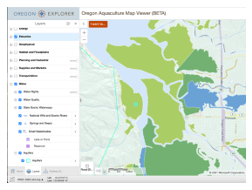EXPANDING AQUACULTURE INVESTMENT IN OREGON USING A NOVEL GEOSPATIAL AND FINANCIAL PLANNING TOOL
The Oregon Aquaculture Association (OAA), Business Oregon, Oregon State University (OSU), and Oregon Sea Grant (OSG) are currently expanding data and species profiles for their Oregon Aquaculture Explorer Platform. This Platform includes a geospatial and financial planning tool (Oregon Aquaculture Financial Planning Tool) that allows potential entrepreneurs and investors to explore spatial resources and develop plans for aquaculture business opportunities.
Currently, the tool has been built and peer reviewed for three inland aquaculture species (specifically, tilapia and sturgeon in recirculating systems, and hybrid striped bass in ponds). W e are now in the process of beta testing and expanding the tool to include coastal shellfish and seaweed aquaculture products. The functionality of the tool will remain the same for the new species including using a GIS platform . The tool allows the user to select a site (choosing on a map or entering an address), develop an initial resource site report, and then determine likely costs for inputs including energy, water, feed, seed, and labor. Each of these costs can be refined based on the user's estimates. A unique attribute of the platform is directly linking spatial data as inputs into the financial models. The tool allows the user to run multiple scenarios based on alternative production levels, costs, output prices, and resource constraints. Start-up costs, including construction and materials, are also considered. The tool provides a down loadable E xcel file for the user to conduct m ore detailed and site specific analysis.
Although the initial phase pf the project has focused on inland species and systems, phase two will focus on marine species and coastal and estuarine aquaculture. With the exception of oyster culture, estuarine and nearshore aquaculture is limited in Oregon . New research will focus on investment opportunities and challenges for novel and emerging systems and species such as red seaweed (dulse), abalone, and scallops .
The goal of this presentation is to provide an introduction to and overview of the Oregon Aquaculture Expl orer Platform and tool , and to elicit feedback and conversation around potential refinements, species, and concerns. While the tool has undergone peer review for the inland species, the coastal species are new, and additional considerations will be necessary before the full release of the tool.
